HCHS President's Message
HCHS volunteers are still busy at work. It is a lovely time of the year to be out exploring, and new discoveries are being made. John Shuck and Kim Schwartz have joined Vicki Stephens on the Cemetery Committee, and they have been out in the field photographing and recording grave information along with GPS readings that will eventually be compiled into a second edition of Henrico County Cemeteries. We thank them for their efforts.
This information can be extremely important for those researching their genealogy, and in the case of future development plans, the documentation of sites will ensure that the graves will be properly handled.
Many of the graves and cemeteries are found at former home sites, where in earlier times a portion of a family's property was set aside to lay their loved ones to rest. Often there was a sizable amount of property involved, which made it attractive for development. It is not unusual to find small family cemeteries surrounded by modern day developments. Some are well maintained and some are not, which makes it more urgent to record the information before it is lost forever.
Graves are sometimes found in the middle of wooded areas that are disappearing at an alarming pace. One site was found when in discussion about a new development at Patterson Avenue and Gaskins Road, the resident of an adjoining neighborhood mentioned that as children they found a cemetery in the wooded area. We have recently recorded that information, and the developer has respectfully erected a fence designating the site.
Grave yards connected to churches are generally maintained but not always documented. The Cemetery Committee is in the process of identifying those that remain to be recorded.
If you have any information about grave sites in your area, or if you would like to participate on the committee, please contact Vicki Stephens at 804-227-3673 or by email arnim@westhanover.net.
Another exicting development: On October 22-25, 2008, there will be a reunion of the USS Henrico at the Radisson Hotel Norfolk. A delegation from the Henrico County Historical Society will participate in the opening ceremony welcoming committee. If anyone would like to participate, please contact me at 804-839-2407.
In addition, HCHS has been asked to be the repository of artifacts relating to the history of the USS Henrico. We are pleased to have been chosen to receive this honor. The collection includes a large photo of the ship and a piece of the Japanese plane that hit the ship and killed many onboard, as well as other items and photos.
Congratulations go out to HCHS member Patty Kruszewski for her Virginia Press Association's annual News and Editorial Contest award.
Patty, who is managing editor of the Henrico Citizen, also won 10 awards in the Virginia Press Womans 2008 Communication Contest and in addition was named Henrico Business Leader of the Year.
Congratulations also to members Peter and Sharon Francisco who were named Henrico Community Volunteers of the Year by the Greater Richmond Chamber of Commerce.
I hope you can join us for our 33rd Annual Meeting as we go foward into our 34th year.
Sarah Pace
President
>Back to Top<
Celebrating the Proud History of the USS Henrico

In October, when former crew members of the USS Henrico hold their reunion in Norfolk, they should have plenty of stories to swap and memories to share. During her years of service (1943-1968) in the United States Navy, the Attack Transport 45 (APA-45) named for our county saw action in war and peace and endeared herself to the crew members who served aboard her.
Originally built to serve the Ingalls Shipbuilding COrporation of Pascagoula, Mississippi, in 1942/43, the ship sailed under the name SS Sea Darter until it was converted to an attack transport and commissioned the USS Henrico on 26 November 1943. Under the command of Navy Commander John H. Willis, the USS Henrico reported for duty in the U.S. Atlantic Fleet with Transport Division 11 on 3 December 1943; and the rest, as they say, is history. Highlights of her proud history include:
- D-Day, 6 June 1944: The USS Henrico was part of the Omaha Beach assault force. After the Normandy invasion, she participated in the landing at Baie De Pompelonne in Southern France.
- Invasion of Okinawa, 21 March until the night of 2 April 1945: On that night, the ship was hit by a Kamikaze bomber and suffered heavy damage. Thirty-seven Navy and fourteen Army personnel lost their lives from this attack.
- Participation in Operation Magic Carpet, January to May, 1946: This operation saw the return of war veterans to the United States.
- Support of Operation Crossroads, June through August, 1946: This operation involved atomic bomb testing at Bikini Atoll.
- Landing at Inchon, Korea, 15 September 1950
- Hong Kong visitation, February 1952: The ship represented the United States in ceremonies marking the death of England's King George VI.
- Landing of the first U.S. combat unit in Viet Nam, 8 March 1965: Troops landed at Da Nang, Hue, and Chue Lai.
By the time the USS Henrico was decommissioned on 14 February 1968, she had served her country well for 25 years. We salute the USS Henrico and all who served aboard her.
>Back to Top<
Vet Seeks Families of Henrico Soldiers Lost in Korea
In our continuing effort to highlight the contributions of Henrico veterans, we received a special request. We recently received the following letters, asking for information about families of four Henrico soldiers lost in Korea:
I am searching for the family of four soldiers who were killed in the Korea War. When they entered service, they gave Henrico as their home of record. The soldiers are:
DAVID GOODWIN APT PVT-E2
Born: Jan 11, 1932
Caucasian
Date of loss: Nov. 21, 1950
Killed in Action (KIA)
B CO, 15 INF RGT, 3rd INF DIV
RA13351317
EDMOND VERNON BELL PVT-E2
Born: fEB. 1, 1932
Black
Date of loss: Oct. 19, 1952
Missing in Action (MIA)
L CO, 17 INF RGT, 7th INF DIV
RA13319021
ROBERT CORBIN COX CPL-E4
Born: Sept 28, 1930
Caucasian
Date of loss: July 11, 1950
Prisoner of War (POW)
L CO, 21st INF RGT, 24th INF DIV
RA13166998
WILLIE WILLIAMS, JR. PFC-E3
Born: Dec 11, 1930
Black
Date of loss: August 12, 1950
Killed in Action (KIA)
G CO, 24th INF RGT, 25th INF DIV
RA13166501
When the Korean War ended, over 8,000 of our servicemen were not returned or accounted for. That was over 50 years ago. Since that time DNA analysis has advanced, and remains are being recovered in North Korea. Our government is obligated to return those remains to the proper familes. DNA samples have been obtained from most of the families of these missing soldiers. For various reasons, some families have not been located. There are 60 families from Virginia that have not been located, four of whom are from Henrico County.
When the remains are recovered and identified, they will be returned to the family for proper burial. I am just an old (76 years) Combat Veteran of the Korian War and thankful that I did return. I consider this a very noble cause, and I hope that you can help in some way to find these families. For more information on the project, you may go to www.jpac.pacom.mil. My part in the program is to match up the lost families with the proper agency.
I will be grateful for any assistance in locating these families.
Harold Davis
40th Infantry Division
Korea '52-'53
910-791-2333
hgdavis@bellsouth.net
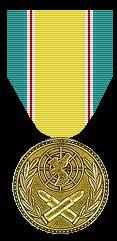
The Korean War Service Medal was awarded by the Republic of Korea to military personnel who served between the outbreak of hostilities on June 25, 1950, and the signature of the armistice on July 27, 1953, for a minimum of 30 consecutive days or 60 non-consecutive days within the territorial limits of Korea, in the waters immediately adjacent or in flight over Korea participating in actual combat operations or in support of combat operations
>Back to Top<
Virginia Randolph, Educator and Innovator
Source: The African American Atlas Black Histry and Culture on Illustrated Reference and PROFILE: Virginia Randolph at www.richmond.com.
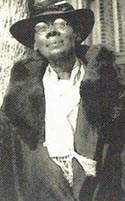
Born on June 8, 1874 to former slaves Sarah Elizabeth carter and Edward Nelson Randolph, Virginia Estelle Randolph went on to notoriety as an African-American educator, social worker and humanitarian.
Growing up during Reconstruction, she became a teacher by the time she was 16, first teaching in Goochland, and then at the one-room Mountain Road School in Henrico County.
Besides academics, Randolph taught her students such skills as gardening, woodworking, and sewing. Her methods at times were unconventional - she once dismantled a neighbor's stove that was still warm and took it to school to teach a cooking class. While the methods brought opposition from parents who wanted their children to learn from books, the county superintendent stood behind her. In 1908, Randolph was appointed the first Jeanes Supervisor Industurial Teacher, providing the first formal in-service teacher training anywhere in Virginia for rural black teachers.
Free to design her own agenda, she shaped industrial work and community self-help programs to meet specific needs of the 23 schools she supervised. Reaching those schools took up to three hours one way on often-rough country roads. The expense of hiring a bugger and driver consumed much of her salary.
She recorded the improvements made at each school under her program. Called the "Henrico Plan," it was sent to county superintendents throughout the South. Randolph's teaching techniques and philosophy were later adopted in Britain's African colonies.
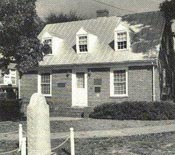
In 1915, the Virginia Randolph Training School was built. Students enrolled from throughout the county; but transportation was not provided, so Randolph often kept children in her home. Some 59 children boarded with her, and she built separate dormitories for girls and boys. Students came to her school from as far as New York. in 1929, fire destroyed the wooden Virginia Randolph Training School A bigger brick school was built later that year and named the Virginia Randolph High School. Virginia Randolph died March 16, 1958. The Virginia Randolph Home Economics Cottage in the picture was established in 1970 and dedicated to preserving the memory and accomplishments of Virginia Randolph.
>Back to Top<
A Few Notes On Our Tobacco Heritage
Westham
This small trading town in western Henrico was laid off into 150 lots with streets in 1752. THe main road through Westham was Westham Plank Road, which is now Cary Street Road, on which tobacco warehouses were located.
Varina Magisterial District
In 1610, John Rolfe settled on what is now known as Varina Farm. He cultivated a tobacco that was a cross between Indian tobacco and the Bermuda tobacco. The resulting was crop that was similar to tobacco being grown in the Spanish Varinas, so Rolfe named his tobacco plantation Varina.
Patterson Avenue
Dr. Richard Archibald Patterson, tobacco manufacturer and doctor, and Thomas C. Williams started a tobacco business that, like many other businesses, failed with the onslaught of the Civil War. He bacame a surgeon for the Confederacy and after the war operated a small farm in Henrico and practiced medicine. Then one day he received word that a tobacco shipment made by his now defunct tobacco company had made it through the wartime blockade. The money from the sale had been kept for him until after the war to insure that he received it. With the money, Patterson re-opened his tobacco business under the name of R. A. Patterson & Company, and he prospered. A road was cut through the property and named Patterson Avenue. The Patterson Tobacco Company was bought out by the American Tobacco Company, which kept the Lucky Strike Brand, an original brand of the Patterson Company.
New Market Road
The original colonial tobacco market was in Williamsubrg, and tobacco growers in Henrico needed another market. Richmond was the most likely candidate. They began to call Richmond "New Market" and the road that led to it, the New Market Road.
>Back to Top<
Montezuma
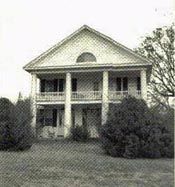

Built around 1910, this Georgian Revival house, which has just recently been razed, stood on the site of the original Montezuma, home of John Poole Schermerhorn, a maker of stoneware. It overlooks Route 360 just east of the I-95 interchange. Schermerhorn and many of his family are buried in the cemetery on the grounds. All but two of the graves are unmarked. Two of these are of his grandson, John S. Austin, and his wife, Sallie B. Austin. The obelisk memorializes Schermerhorn's in-laws, James Parksinson and Mary Polly Shields Parkinson.
>Back to Top<
Local Nineteenth Century Stoneware
Sources: Ceramics in America, robert Hunter, ed. (2005) and "Stoneware of Eastern Virginia," Antique, 1 April 2005.
Among the early industries of Henrico County was stoneware manufacture, which apparently expanded from Richmond in the first or second decade of the nineteenth century. Pharmacist Benjamin DuVal was manufacturing salt-glazed stoneware vessels to supply pharmacies, distilleries, dairies and mercantile operations. It appears that he hired New York potter John Poole Schermerhorn around 1813, and by 1820 Schermerhorn had established his own manufactory at Rocketts Landing by the James River.
It was a sizable operation. The 1820 Manufacturers Census for Henrico County shows that he had made use of 50 tons of clay, 80 cords of wood and 18 sacks of salt (for glazing). He employed three men and no boys, ran one kiln and three wheels and paid $300 in wages and $500 in other expenses to produce "stoneware of all kinds".
Only six marked examples of Schermerhorn's work are known, but other examples can be identified by thick walls, even glazing and ovoid forms with handles. Decorations include unique brushed cobalt blue blossoms or circular peach-shaped blooms. Most likely, early Richmond potters were associated with Schermerhorn at his Rocketts Location and at his potteries in southern Henrico County. The 1820 Census of Manufacturers, Henrico County, lists Thomas Amos, stoneware manufactory; Samuel Frayser, stoneware manufactory; John P. Schermerhorn, stoneware of all kinds; and Samuel Wilson, stoneware of all kinds.
At any rate, as the authors of "Stoneware in eastern Virginia" (Antique, 1 April 2005) claim, "Several elusive, and in some cases unidentified, potters or pottery schools are known to have operated in Richmond and Henrico County to the southeast along the James River as early as 1816. Based on the identification of extant wares that share distinctive attributes of shape, decoration, and regional provenance, four distinct groups have been tentatively defined."
The second group, tentatively attributed to Samuel Frayser, have well-defined rims and necks, applied extruded handles and brushed cobalt blue flowers. These flowers have curving leaves that end in a petaled bloom. Frayser's pottery was in the vicinity of New Market near Fourmile Creek.
The third group was influenced by Baltimore potters and is most closely identified with Thomas Amos who operated in Baltimore between 1810 and 1817. Between 1818 and 1823, Amos produced pottery on Fourmile Creek, about ten miles southeast of the Henrico County Courthouse. These semi-ovoid pots have well-defined collars, small, slightly rolled rims and curved handles whose blunt ends are brushed with cobalt blue. They are often decorated with two cobalt blue swags extending from a central blue flower to the handles.
A single stem extending from two opposing leaves and ending in a cloudlike flower mark the fourth group. Sometimes, there is no stem, and decoration seems even more cloudlike. These are attributed to Stephen B. Sweeney, a Henrico potter who in 1860 was operating what appears to have been a retail outlet for his productions in Richmond on Fourteenth Street between Cary and Dock Streets.
>Back to Top<
Kiln Furniture and Crocks from Henrico Potteries
Sources: Descriptions and photographs of stoneware from www.artifact.com (09/23/15 - this website no longer exists) and www.greenvalleyauctions.com
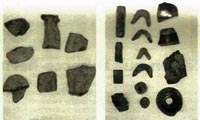
These examples of kiln furniture are housed in the Virginia Department of Historic Resources and were photographed there. They were used during the firing process to separate or support stoneware items in the kiln. Those on the left were found at an archaeological dig at the waster dump of the Norwich pottery on the west side of Bailey Creek. The items in the photograph on the right were found at the site of the Sweeney pottery. The Department of Historic Resources also has a number of other potsherds from the Norwich pottery, the Sweeney pottery, and the DuVal pottery, the pottery for which John Poole Schermerhorn first worked.
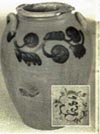
Attributed to John P. Schmerhorn, this very rare three-gallon ovoid stoneware jar has a brushed cobalt date "1839" (inset) within a scalloped border accented with tassel-like brushwork. It has a tooled flaring collar and applied lug handles. It is decorated on one side with a vine of cobalt leaves and circular flowers. It is also decorated with a cobalt "3" underscored by a brushed S-shaped flourish, possibly used to represent the name "Schermerhorn". Very few dated Schermerhorn pieces are known. (14"h)

Attributed to John P. Schermerhorn, Samuel Wilson, and/or associates, this approximately three-gallon ovoid stoneware pitcher has incised upper shoulder rings and concave molded rim, brushed cobalt single flower decoration and additional cobalt at rings, rim, and handle terminals. (15 1/2" h, 6" diameter rim)

Attributed to Stephen B. Sweeney, this semi-ovoid salt-glazed stoneware jar with two rolled handles and three incised shoulder rings, brushed cobalt spitting tulip decoration both sides has a capacity of approximately three gallons. (13 1/2"h, 7 1/4" diameter rim)

Also attributed to Stephen B. Sweeney, this semi-ovoid stoneware jar wiht two rolled handles and incised shoulder ring and brushed cobalt cloud-like decoration on both sides has a capacity of approximately one half gallon. It also has additional cobalt at handle terminals. (8 3/4"h, 5 1/2" diameter rim)

Attributed to John P. Schermerhorn, Samuel Wilson, and /or associates, this stoneware jar bears a "3" capacity stamp. It is ovoid in form with two pulled handles, incised shoulder rings, and a short neck. It also has brushed cobalt floral decoration on both sides. (13"h, 7 1/2" diameter rim)
It was a sizable operation. The 1820 Manufacturers Census for Henrico County shows that he had made use of 50 tons of clay, 80 cords of wood and 18 sacks of salt (for glazing). He employed three men and no boys, ran one kiln and three wheels and paid $300 in wages and $500 in other expenses to produce "stoneware of all kinds".
Only six marked examples of Schermerhorn's work are known, but other examples can be identified by thick walls, even glazing and ovoid forms with handles. Decorations include unique brushed cobalt blue blossoms or circular peach-shaped blooms. Most likely, early Richmond potters were associated with Schermerhorn at his Rocketts Location and at his potteries in southern Henrico County. The 1820 Census of Manufacturers, Henrico County, lists Thomas Amos, stoneware manufactory; Samuel Frayser, stoneware manufactory; John P. Schermerhorn, stoneware of all kinds; and Samuel Wilson, stoneware of all kinds.
At any rate, as the authors of "Stoneware in eastern Virginia" (Antique, 1 April 2005) claim, "Several elusive, and in some cases unidentified, potters or pottery schools are known to have operated in Richmond and Henrico County to the southeast along the James River as early as 1816. Based on the identification of extant wares that share distinctive attributes of shape, decoration, and regional provenance, four distinct groups have been tentatively defined."
The second group, tentatively attributed to Samuel Frayser, have well-defined rims and necks, applied extruded handles and brushed cobalt blue flowers. These flowers have curving leaves that end in a petaled bloom. Frayser's pottery was in the vicinity of New Market near Fourmile Creek.
The third group was influenced by Baltimore potters and is most closely identified with Thomas Amos who operated in Baltimore between 1810 and 1817. Between 1818 and 1823, Amos produced pottery on Fourmile Creek, about ten miles southeast of the Henrico County Courthouse. These semi-ovoid pots have well-defined collars, small, slightly rolled rims and curved handles whose blunt ends are brushed with cobalt blue. They are often decorated with two cobalt blue swags extending from a central blue flower to the handles.
A single stem extending from two opposing leaves and ending in a cloudlike flower mark the fourth group. Sometimes, there is no stem, and decoration seems even more cloudlike. These are attributed to Stephen B. Sweeney, a Henrico potter who in 1860 was operating what appears to have been a retail outlet for his productions in Richmond on Fourteenth Street between Cary and Dock Streets.
>Back to Top<
Tools for Linen Production
You might go to a bit of trouble to take care of that linen suit or blouse you own, but it's nothing compared to what our early ancestors went through just to get linen. The "What Do You Know?" objects in the production of this very durable material derived from flax fibers.
Flax, a slender, grass-like, annual plant with narrow leaves, was planted in early spring and bloomed wiht small light blue flowers in early summer. When seed pods replaced the flowers, the flax was ready to be harvested, usually by pulling the plant from the ground rather than cutting in order to maintain long fibers. Today's linen is not as strong because the fibers must be cut to accommodate modern machine processing.
The fibers used to produce linen were found on the inside of the stalk. To separate the fibers from the stalk, the flax had to be retted, a process of soaking to dissove the natural glue which bound the flax fibers to the stalk. This was often done by laying the flax on the grass to absorb the dew or by placing it in a stream or pond.
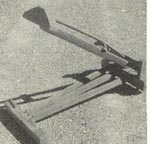
To separate the fibers for spinning, the stalks were placed one handful at a time, into a flax break, the large wooden device seen in the photograph. The stalks were laid across the base of the break, and the large handle was repeatedly brought down to crush the outside stalk.
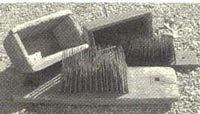
Next, the flax was held against a vergical board and beaten with a wooden scutching knife to further reduce the outer stalk. Lastly, the flax was dragged one handful at a time through a series of progressively smaller heckles (or hackles). Heckles are those wooden boards with iron spikes seen in the picture. They acted as a comb to smooth the fibers. The coarser fibers which remained in the heckle were called tow. (That's where we get the term "tow headed")
Next came spinning, normally a winter chore performed by the women and girls of the household. The tow was spun to produce coarse cloth for feed bags and the like. The finer flax was twisted into bundles called stricks and then spun.
The spun thread was then sent to the weaver, who most likely kept a portion of the cloth as payment. Very few 18th century households had their own full-sized loom because of their size and cost. However, some households had smaller looms on which a small quantity of narrow cloth could be produced.
Total production time from seed to clothes could take a year to a year and a half, so linen clothing was patched and reused until it was no longer of any use. But even then, linen still had a purpose to serve: linen rags were collected by paper mills and converted to paper.
>Back to Top<
Sandston Virginia: The First Twenty-Five Years
Source: History Online http://vaauthors.mytimesdispatch.com/index.php/vaauthors/P21/, July 17, 2007 7:58 AM (09/23/15 - this link no longer exists)
The Founders Club of Sandston has published a history of the village, with emphasis on its earliest years, 1921-1946. The Founders Club of Sandston includes Alice Taylor Baldwin, the Club's President and a member of the Henrico County Historical Society.
The hardbound, limited edition book has 275 pages and includes excerpts of the 1920 and 1930 federal census, over 350 photographs, early maps of the area, a bibliography, and index. The publication was compiled by June Banks Evans, a former resident of Sandston now retired after 32 years of teaching.
A documented chapter of Sandston's history is followed by personal memories and vintage photographs representative of 84 different families who lived there during its first 25 years. The common thread in these narratives is of a community growing up along with its residents, providing the children with a sense of place now appreciated as a nurturing element for confidence and assurance. The parents and guardians assumed the problems, the children enjoyed the benefits, and as Sandston grew, so did they, the narrators of these poignant memories.
Price: $38 (Add $4 to mail one copy, $1.50 each additional copy)
Mail orders: Esten H. Shomo, 2630 Salisbury Rd, Midlothian VA 23113
Local pickup: Alice Taylor Baldwin, Highland Springs 737-1868. Although quantity available is now limited, many local libraries include this book in their collections.
>Back to Top<
HCHS Events - Second Quarter
Sunday, June 1st, 2:00PM
Join us at the Armour House and Gardens at Meadowview.
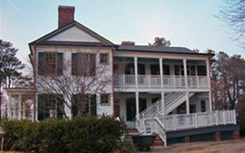
The Armour House was built between 1915 and 1918 in the Victorian style and is rich in Henrico family history. The most recent owner of this home was Alex Armour, who acquired the property in 1944. Henrico County purchased the Armour House in 1999.
In the early 19th century, Chief Justice John Marshall had a country house nearby known as Chickahominy Farm and spent weekends there relaxing and farming the land. Meadowview is also historically significant as the site of rifle pits near the Chickahominy Bluffs, from which General Robert E. Lee viewed the beginnings of the Seven Days Battle. In addition, achaeologists have identified the Meadowview Park area as the site of Native American hunting grounds dating to 10,000 B.C. and have also found indications of a settlement around 400 A.D.
As a special highlight, we have the very good fortune to have Mary Stuart Cruickshank coming to speak. Ms. Cruickshank lived at the Armour House with her family from birth to age 6 but continued visiting the home as she got older to swim in the spring-fed swimming hole. Ms. Cruickshank will be able to give us a unique and personal perspective on this fine old home.
Pack a sandwich or picnic lunch, and we'll provide the drinks and dessert at the picnic shelter. Please RSVP to Linda Dickerson (364-3492 or ldickerson@oag.state-va.us) as soon as possible so we will have sufficient dessert and drinks and so that we can let our tour guide make arrangements for our tour.
Directions: From I-295 take Creighton Road South. From I-64 take Creighton Road North. Turn onto Cedar Fork Road and go past Bogart Road on the right. Proceed on Cedar Fork Road and turn right onto Clarendon Road. The park is behind the Arthur Ashe Elementary School.
>Back to Top<
News 2008: Second Quarter
First Quarter | Third Quarter | Fourth Quarter
Home | Henrico | Maps | Genealogy | Preservation | Membership | Shopping | HCHS
|











